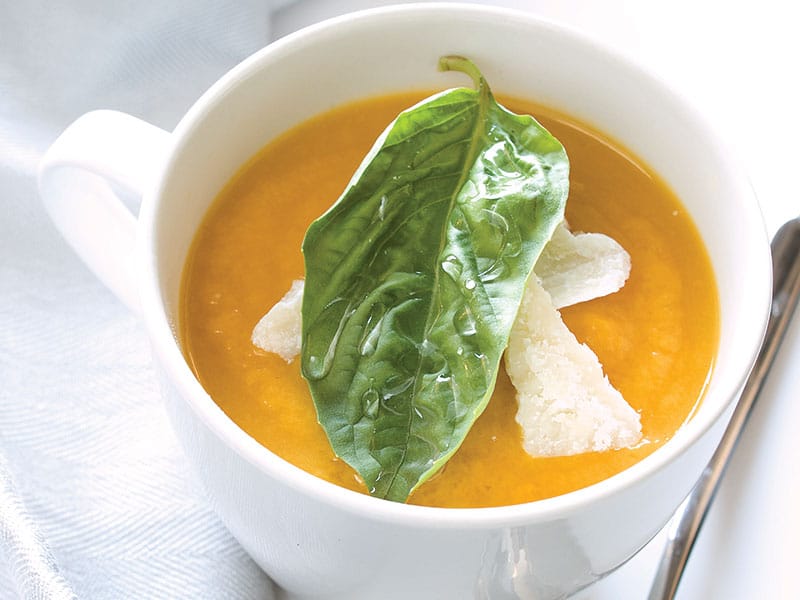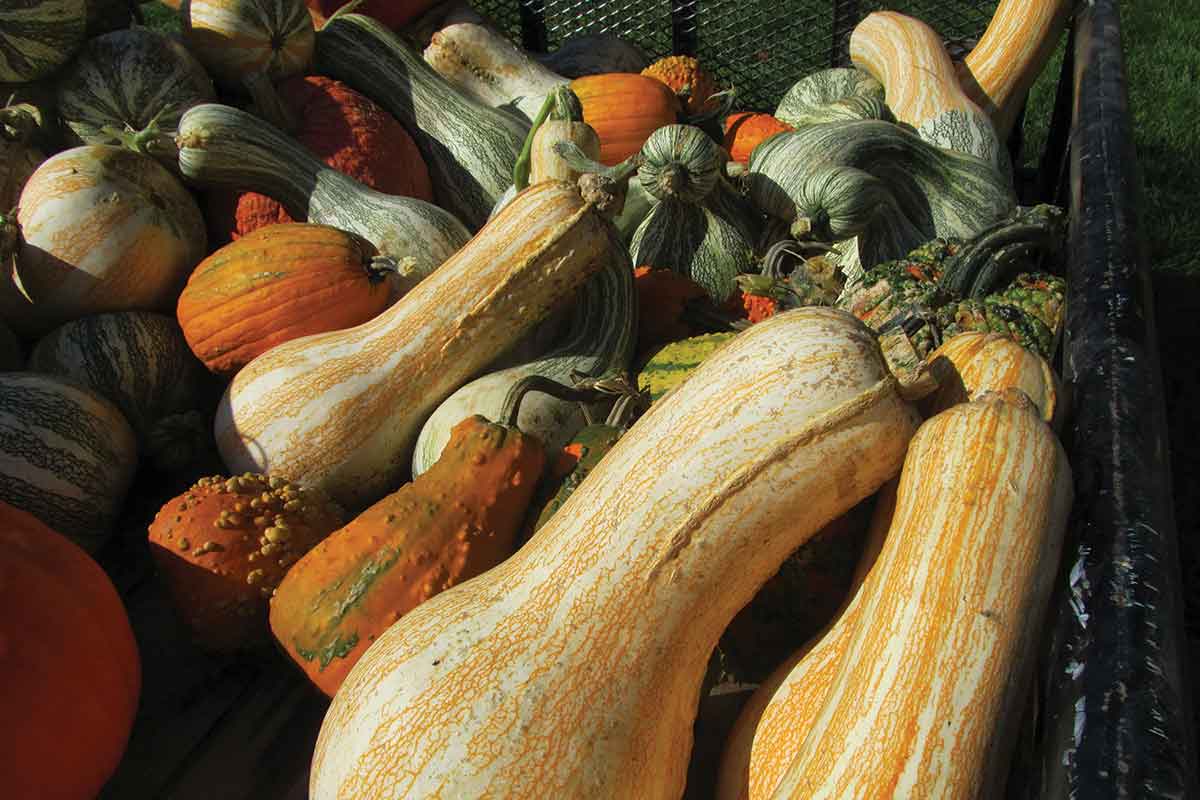Pumpkins are good for so many things. Pie, curries, beer, decorations, and heck, you can even bowl with them. Learn all the wonderful things pumpkins have to offer and why this fruit is so versatile. Maybe you’ll bowl a strike too.

By Tina Casagrand
THE GREAT PUMPKIN
(printed in the 2013 issue, so any people events, or places were current in 2013)
Explore this fall fruit’s iconic status.
BY TINA CASAGRAND
PEOPLE TREAT pumpkins as icons, says Kate Kammler, horticulturist for the University of Missouri Extension in Ste. Genevieve. Maybe it’s because they’re round. Or orange. Or magical.
“Pumpkins are contagious,” she says. “People always smile when they see them. I’ve never been around anything else quite like that.” One of the state’s only pumpkin experts, she started at age fourteen, raising plants for an FFA project. At sixteen, a neighbor hired her to help in his pumpkin patch.
“He didn’t want to hire a girl, but then he found out that girls worked harder than the boys did,” she says. This makes her laugh, an infectious chortle. One other girl worked with Kate and a handful of boys, pluck- ing pumpkins off the vine and slashing corn stalks with machetes. “You know, picking fifty acres of pumpkins by hand takes a while,” she says, explaining in detail the tedious process.

Delivering a day’s haul made her feel like a star. “There’s nothing like pulling up to a grocery store and seeing kids point and smile,” she says. Pumpkins were once a major food source before World War II, according to Kate, and for good reason. They keep well. They’re easy to grow. They’re nutrient rich. But after World War II, the food became a symbol of bounty, a decoration to put on your porch.
“People don’t cook anymore,” Kate says, shrugging. She bakes with fresh pumpkin for her master gardener classes and makes a few side dishes, but otherwise doesn’t cook much with her own harvest. Instead she grows them, 140 different varieties this year alone.

Photo credit: Tina Casagrand
Raising pumpkins is surprisingly fun. There are only five domesticated species in the genus Cucurbita but an endless rainbow of varieties. Think of the variety of sizes, shapes, colors, and behaviors of the household dog, and you get an idea of how the Cucurbita pepo, a single species, boasts a brilliant diversity of plants.
“The pepo, which are your zucchini, crookneck, any of your jack-o’-lantern type pumpkin, pattypan squash—those can all cross,” Kate says, as she scrolls through her presentation for master gardeners. “So if you save seeds from those, next year, who knows what you might get, which I think is part of the fun. That’s what I like!”
Kate earned her master’s researching pumpkin seeds at Southern Illinois University—our neighbor to the east produces the most pumpkins in the nation—and became an extension specialist five years ago. She’s not sure what was better: settling in a nice place to raise pumpkins or landing her dream job well before age thirty.
One of Kate’s mentors is Dianna Koenig. Dianna is a success story for agritourism, but that’s an understatement.
Dianna is a force of nature. “Everything fall!” is her motto. She sports pumpkin earrings. She wears an orange polo. Her whole family wears orange polos with Perryville Pumpkin Farm stitched on the chest.
What started as a way to add income has become a two-month-long festival of sorts. The pumpkin business grew slowly, but Perryville Pumpkin Farm is now as diverse as squash with a play pit of shelled corn, nature trails, a mini golf course, pumpkin bowling, hayride, corn maze, country store, and big bale jump. And, of course, there are pumpkins, ten acres with at least eighty varieties. People flood the fields to pick pumpkins that range from fifty cents to ten dollars.
The family starts planting pumpkins in June to ensure they are ready to pick by Labor Day, and Dianna’s sons return each fall to help out. “Pumpkins bring people together,” Dianna says. “They bring us together for sure.”
With nearly a hundred varieties, there’s plenty of fleshy, sweet squash ready to cook. But Dianna estimates that only about two percent of visitors use them for food. Still, pumpkins taste great in pie, espresso drinks, beer, bread, and more. Plus, they can also star in savory soups when given the chance. You can grill pumpkins or store the squash whole to make fresh dishes all winter. But at the end of the season, they still don’t sell as well. Dianna echoes Kate: “It’s just a lot easier to open a can.”
Not everyone is won over by the convenience of a can, though.
“Canned pumpkin is always kind of mushy and not so usable,” says Bruce Lynch, a manager and cook at Chim’s Thai Kitchen in Columbia. “If you pick a canned product, it’s in a syrup or some kind of water, and the flavor profile is extremely different from that of a fresh one.”
Think of pumpkins as you would pineapples; the difference between the canned product and the fresh one is obvious. That’s why Chim’s always uses fresh ingredients. The Thai eatery serves pumpkin in red curry all year, so when fresh pumpkin is unavailable, a similar tasting squash, such as butternut squash, is substituted.
Squash and pumpkin have similar culinary qualities, so they can often be interchanged. But look out for which pumpkin is being used. Some pumpkins are sweet or even tart, such as the smaller greener ones, and some are rich and nutty, such as white pumpkins. The rich variety in flavor means they’re not limited to sweet desserts, as Chim’s robust pumpkin and red curry sauce demonstrates. It’s why Bruce and Chim’s owner Pramuan “Chim” Duncan consider pumpkins more of a food than a decoration. Sometimes, though, they’re both.
“You can still use the ones you’ve carved on as long as you picked out a half-way decent one,” Bruce says. “Well, as long as you haven’t put a candle in it.”
Nobody wants to eat wax.

Another culinary commodity that doesn’t skimp on pumpkins is American beer. Missouri’s offerings are some of the nation’s best.
Anyone in the state can enjoy local autumnal ales all season long. Mother’s Brewing Company of Springfield calls its ale Mr. Pumpkin. Kansas City’s Bourgmont Brewing Company makes a smoky pumpkin ale. O’Fallon Brewery’s offering tastes “like pumpkin pie in a bottle,” and Schlafly’s ale ranks high among beer critics.
Larry Goodwin, master brewer of Flat Branch Pub and Brewing in Columbia, guesses that pumpkin beer was revived with craft brewing.
“I just inherited a recipe when I took over in ’99, and I’ve just kind of tweaked it or improved it or changed it over the years,” Larry says.
He buys pumpkins from Hartsburg before the annual pumpkin festival, and then some employees spend most of a day cutting and steaming them. Inch-size chunks cool overnight and are put into a mash tun. Pumpkin pie spices get added in the kettle, and then Larry comes back with more spice to adjust the flavor.
Columbians love it. In 2012, Flat Branch’s double-batch of five hundred gallons sold out in three days, after its Halloween release.
“It’s kind of a multi-headed monster at this point,” Larry says. “It involves a fair amount of extra work, but the people just enjoy it, and they start anticipating it in July or August. Each year we just wonder if it’s going to sell out faster than the year before.”
The pumpkin pandemonium that strikes Flat Branch every year is just one example of the squash’s iconic status, but the fruit really has seeped into all things autumn.
Pumpkins can be found everywhere from lattes at local coffee shops to family kitchens to microbreweries across the state. And from 7 am until 7 pm from Labor Day until November, children and adults alike play and pick pumpkins at the Perryville Pumpkin Farm. In fall, people eat, decorate, and even play with pumpkins.
Maybe, pumpkins are so pervasive in fall because orange is the unofficial color of autumn. Or maybe, pumpkins are magical. After all, how did Cinderella make it to the ball?
Learn more about the Perryville Pumpkin Farm (they are open now) here.
Article originally published in the October 2013 issue of Missouri Life.
Related Posts
A Pumpkin Palooza by the River
This lovely river town hosts a pumpkin palooza that will delight all with pony rides, a monkey bus, a merchants’ candy crawl, story time, Lollypop the balloon artist, costume judging, pumpkin rolling, plus concessions and vendors.
Pumpkin Basil Bisque
This recipe is courtesy of Colleen Smith, owner, Tea Bar & Bites Café in Springfield



